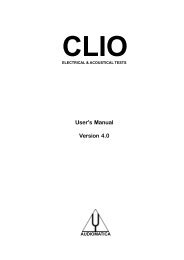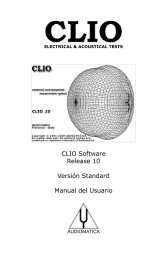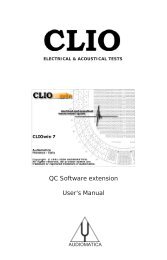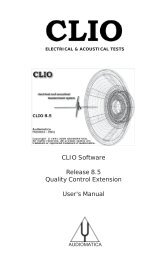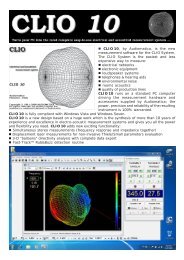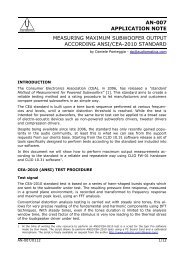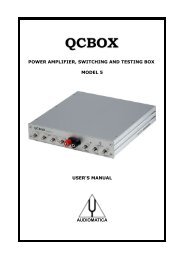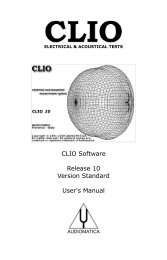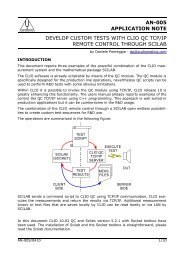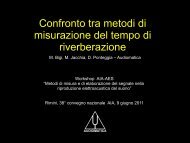CLIOwin 7 PCI User's Manual - Audiomatica
CLIOwin 7 PCI User's Manual - Audiomatica
CLIOwin 7 PCI User's Manual - Audiomatica
Create successful ePaper yourself
Turn your PDF publications into a flip-book with our unique Google optimized e-Paper software.
12.3.2 WATERFALL OPERATION<br />
As already stated, the data source for a CSD or ETF waterfall is a measured impulse<br />
response<br />
Once you have loaded an impulse response inside the Waterfall control panel you may<br />
easily inspect it, in the same way you also do with the MLS Impulse control panel (see<br />
chapter 10). Of great importance is to select the start time and stop time of the analysis:<br />
start time, the Start Window value selected in the impulse response represents time<br />
zero for the waterfall; stop time, the Stop Window value selected in the impulse<br />
response represents the last processed CSD slice unless a different Time Shift has been<br />
selected.<br />
CSD (Cumulative Spectral Decay) is intended primarily for anechoic loudspeaker<br />
evaluation; in this case only the data between the start and stop time is analyzed; each<br />
successive slice considers time data from its relative start time (the rearmost, at time<br />
zero, has start time equal to the start window of MLS) to the fixed stop time, the data<br />
being windowed by a particular time window with a smoothed rising edge (see literature<br />
for a discussion about this). Normal values for the Window Rise Time lie within 0.1 and<br />
0.6ms. In CSD mode, should the Time Shift value be left at zero, the routine will<br />
automatically calculate it, spacing the selected Number of Spectra in the interval defined<br />
by start and stop times; if Time Shift is forced by the user be sure to set it small enough<br />
to permit the last spectra to be calculated; if the fixed stop time is passed, then the<br />
calculation defaults as in case of zero Time Shift.<br />
When representing a CSD the program automatically hides the low frequency<br />
part of the spectra that has become unreliable due to the time-frequency<br />
uncertainty principle.<br />
ETF (Energy Time Frequency) is intended for room acoustic evaluation; in this case<br />
all MLS data starting from the start time are computed; then, successive slices are<br />
calculated moving their initial point of the Time Shift value (see 12.3.1 the Settings<br />
dialog).<br />
146 Chapter 12 - Waterfall and Directivity



